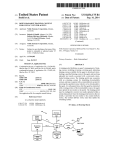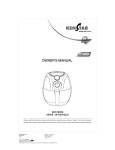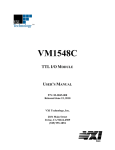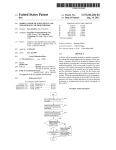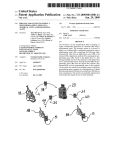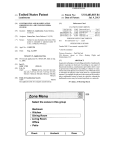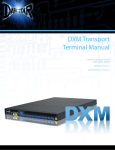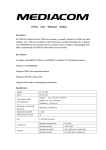Download Method and apparatus for adjusting a speaker system
Transcript
USOO8923997B2 (12) United States Patent (10) Patent N0.: Kallai et a]. (54) (45) Date of Patent: METHOD AND APPARATUS FOR ADJUSTING A SPEAKER SYSTEM . 5,673,323 A 5,946,343 A 6,704,421 B1 . 6,778,869 B2 (75) Inventors: Christopher Kallal, Santa Barbara, CA (Us); MichaelDarrellAIldreW Ericson, Santa Barbara, CA (US) (73) Assignee: Sonos, Inc, Santa Barbara, CA (US) (*) . . Notlce: . . (22) Filed: 8 045 952 B2 ’ ’ 10/2011 h Qures ey e t al. FOREIGN PATENT DOCUMENTS W0 2013012582 A1 1/2013 OTHER PUBLICATIONS Prior Publication Data US 2012/0096125 A1 1/2010 Bralthwalte et al' 9/2010 Holmgren et a1. (continued) Oct. 13, 2011 (65) Cham ion 8/2005 Waller, Jr. et a1. 1/2007 Martin et a1. 8/2009 Lambourne et a1. U.S.C. 154(b) by 665 days. APPl-NO-113/272’833 8/2004 6,931,134 B1 7,171,010 B2 7,571,014 B1 7,792,311 B1 . 9/1997 SchotZ et al. 8/1999 SchotZ et a1. 3/2004 Kitamura 700% Ishidapet al‘ 7,643,894 B2 Subject to any d1scla1mer, the term of this Dec. 30, 2014 6,916,980 B2 patent is extended or adjusted under 35 (21) US 8,923,997 B2 Yamaha DME Desinger 3.5 User Manual; Copyright 2004* Apr. 19, 2012 (Continued) Related US. Application Data (60) Provisional application No. 61/392,918, ?led on Oct. 13’ 2010' Int. Cl. G06F 1 7/00 H03G 5/00 H03G 5/02 H03G 5/16 (52) U-s- Cl- Primary Examiner i Paul McCord (74) Attorney, Agent, or Firm * Hanley, (51) (2006.01) (2006.01) (57) ABSTRACT (2006.01) (200601) Certain embodiments provide methods and systems for man aging a sound pro?le. An example method includes accessing CPC ............. .. H03G 5/005 (2013.01); H03G 5/025 a playback device on a network The example method (201301); H03G 5/165 (201301) includes displaying a graphic interface to allow a user to . . . . . . . . . . . . . . . . . . . . . . . . . . . . . . . . . . . . . . . . . . . . . . . . . . . . . . . . . . .. (58) a Field Of ClaSSi?cation seardl plurality of parameters for user adjustment. The example USPC .......................................................... .. 700/94 method includes saving the sound pro?le The example see application ?le for complete searCh hiStOI'Y- method includes processing an audio signal at the playback _ (56) Flight and Zimmerman, LLC References Clted Us PATENT DOCUMENTS 5,218,710 A 5,553,147 A 6/1993 Yamakiet 31. 9/1996 Pineau 5,668,884 A 9/1997 Clair, Jr. et a1. device according to the sound pro?le, Wherein user adjust ments to the sound pro?le are used to con?gure the playback device to process the audio signal upon saving the sound pro?le. 20 Claims, 7 Drawing Sheets US 8,923,997 B2 Page 2 (56) References Cited U.S. PATENT DOCUMENTS 8,103,009 8,234,395 2002/0078161 2003/0002689 2003/0161479 2003/0210796 2005/0147261 2006/0229752 2007/0003067 2007/0142944 2008/0002839 2008/0025535 2008/0077261 2008/0144864 2008/0162668 2008/0175411 2009/0024662 1/2012 7/2012 6/2002 1/2003 8/2003 11/2003 7/2005 10/2006 1/2007 6/2007 1/2008 1/2008 3/2008 6/2008 7/2008 7/2008 1/2009 McCarty et al. Millington Cheng Folio Yang et al. 2010/0052843 2010/0284389 2010/0299639 2011/0044476 2011/0299696 2013/0022221 A1* 3/2010 Cannistraro ............... .. 340/3.32 A1* 11/2010 Ramsay et al. . 370/338 A1* 11/2010 Ramsay et al. ............. .. 715/835 A1 2/2011 Burlingame et al. A1 12/2011 Holmgren et al. A1 1/2013 Kallai et al. OTHER PUBLICATIONS McCarty et al. .............. .. 381/81 “AudioTron Quick Start Guide, Version 1.0”, Voyetra Turtle Beach, Yeh Inc., Mar. 2001, 24 pages. Chung .......................... .. 700/94 Gierl et al. Goldberg et al. Eng Rajapakse ................... .. 381/311 Baudino et al. ............... .. 700/94 Huon Miller ......................... .. 709/219 Greve Park et al. “AudioTron Reference Manual, Version 3.0”, Voyetra Turtle Beach, Inc., May 2002, 70 pages. “AudioTron Setup Guide, Version 3.0”, Voyetra Turtle Beach, Inc., May 2002, 38 pages. “UPnP; “Universal Plug and Play Device Architecture”; Jun. 8, 2000; version 1.0; Microsoft Corporation; pp. 1-54”. “Yamaha DME 32 manual: copyright 2001”. * cited by examiner US. Patent Dec. 30, 2014 Sheet 1 0f 7 US 8,923,997 B2 , m w w g 4 US. Patent mam Dec. 30, 2014 Wm, i 3i} Wm, M Wm@ Sheet 2 0f 7 US 8,923,997 B2 mam ii?»f, 1.: .H wag?» w mi £3“xgag wham US. Patent Dec. 30, 2014 Sheet 3 0f 7 US 8,923,997 B2 mu unwm w “mg?xx, 3% US. Patent Dec. 30, 2014 Sheet 4 0f 7 m ,x;“ gm wa. mwhmw w .mkw “@me 2 Mama” X?nmay US 8,923,997 B2 US. Patent Dec. 30, 2014 Sheet 5 0f7 US 8,923,997 B2 US. Patent Dec. 30, 2014 Sheet 6 0f 7 US 8,923,997 B2 % 2%, a 5.;9\.V 1. a3. .) 5., EKgR US. Patent Dec. 30, 2014 aw Sheet 7 0f 7 US 8,923,997 B2 US 8,923,997 B2 1 2 METHOD AND APPARATUS FOR ADJUSTING A SPEAKER SYSTEM representations are typically used by those skilled in the art to mo st effectively convey the sub stance of their work to others skilled in the art. Reference herein to “one embodiment” or “an embodiment” means that a particular feature, structure, or characteristic described in connection with the embodiment can be included in at least one embodiment. The appearances of the phrase “in one embodiment” or “in an embodiment” in CROSS-REFERENCE TO RELATED APPLICATIONS The present application claims the bene?t of priority to United States Provisional Application No. 61/392,918 ?led on Oct. 13, 2010,entitled “Method and Apparatus for Adjust ing a Speaker System”, which is herein incorporated by ref various places in the speci?cation are not necessarily all referring to the same embodiment, nor are separate or alter native embodiments mutually exclusive of other embodi ments. Further, the order of blocks in process ?owcharts or diagrams representing one or more embodiments do not erence in its entirety. inherently indicate any particular order or imply any limita BACKGROUND tions. Certain embodiments provide techniques for adjusting loudspeakers (referred to herein interchangeably as speakers) 1. Field of the Invention The present invention is related to the area of audio devices, and more speci?cally related to techniques for adjusting a speaker system or loudspeaker via a network. via the Internet. The adjustment includes at least tuning, con?guration and creation of customized equalizers (EQs). In 2. Background Designing and ?ne tuning of loudspeakers are often a labo rious process. In a typical process, certain electrical compo nents have to be repeatedly changed or adjusted to generate a 20 ?nal “sound” of the loudspeaker. In another embodiment, a set of settings can be remotely adjusted or shared with another speaker system. new equalization or new ?rmware has to be upgraded on some In an example application, when loudspeakers are placed modern products. Typically during development, a loud speaker is placed inside a large anechoic chamber where one embodiment, a graphic interface is provided to tune a loudspeaker, and allows a user to do quick iteration on the 25 in a listening environment, a customer home or a remote acoustic measurements are gradually taken. After each mea location, the loudspeakers sound can be adjusted remotely by surement, the product is removed from the chamber and brought out to be adjusted and then setup again to be re measured. The process often takes days or weeks until the ?nal sound of the loudspeaker is determined. a professional or an experienced user through the Internet. This allows a listener to be able to select his/her favorite 30 method to connect the speaker to the network via a connec tion, such as Ethernet or wireless 802.11n. For example, the BRIEF DESCRIPTION OF THE DRAWINGS Internet Protocol (IP) address of the loudspeaker is typed into Certain embodiments of the present invention will be readily understood by the following detailed description in conjunction with the accompanying drawings, wherein like 35 reference numerals designate like structural elements, and in values for one or more loudspeaker parameters including tweeter, midrange, woofer, etc. A type, frequency, gain, qual 40 ity factor, etc., can be set for each parameter. Once “logged in” to the loudspeaker, the current settings are loaded into a webpage and/ or other presentation interface, for example. A user can then adjust any/all of the items in each 45 updated in “real-time” (or substantially real-time accounting FIG. 2A shows an example functional block diagram of a player in accordance with certain embodiments; FIG. 2B shows an example of controllers that may be used to remotely control one of more players of FIG. 1; FIG. 2C shows an example internal functional block dia gram of a controller in accordance with certain embodiments; a computer, and the computer screen displays a loudspeaker parameter con?guration layout. In certain embodiments, a con?guration pro?le can be created to specify con?guration which: FIG. 1 shows an example con?guration in which certain embodiments may be practiced; sound from a variety of options, and sometimes share his/her sound with another listener remotely located. In certain embodiments, the loudspeaker incorporates a area. Once the values are entered into each area, the values are for some system processing, storage, and/or transmission delay, for example) on the loud speaker. In certain embodiments, the con?guration webpage can be FIG. 3 shows an example interface in an embodiment to allow a user to graphically adjust various settings via a net designed speci?cally for the loudspeaker under development. work; FIG. 4 shows a ?owchart or process of adjusting various 50 settings in a speaker system; and current number of “tuneable” sections. FIG. 5 shows a ?owchart or process of sharing a pro?le Thus, certain embodiments provide for speaker con?gura between two remotely separated sound systems. tion, con?guration pro?le creation, and con?guration pro?le Certain embodiments will be better understood when read in conjunction with the provided drawings, which illustrate examples. It should be understood, however, that the embodi For example, if a loudspeaker includes ?ve transducers, ?ve sections can be quickly created such that the webpage has the 55 storage. The con?guration pro?le can be referred from one ments are not limited to the arrangements and instrumentality user to another, from one speaker to another, and so on. A referred pro?le can be accessed and implemented at one or shown in the attached drawings. more connected speakers to con?gure the speakers and/or DETAILED DESCRIPTION OF CERTAIN EMBODIMENTS 60 other playback devices for playback output, for example. Brief Description Certain embodiments provide a method for managing a sound pro?le. The example method includes accessing a The detailed description of certain embodiments is pre sented largely in terms of procedures, steps, logic blocks, processing, and other symbolic representations that directly or indirectly resemble the operations of data processing devices coupled to networks. These process descriptions and playback device on a network. The example method includes displaying a graphic interface to allow a user to adjust the 65 sound pro?le, wherein the sound pro?le includes a plurality of parameters for user adjustment. The example method includes saving the sound pro?le. The example method US 8,923,997 B2 3 4 includes processing an audio signal at the playback device according to the sound pro?le, wherein user adjustments to the sound pro?le are used to con?gure the playback device to process the audio signal upon saving the sound pro?le. Certain embodiments provide a computer readable All devices on the network 108 may be con?gured to download and store audio sources or receive streaming audio sources. For example, the computing device 110 can down load audio sources from the Internet and store the down loaded sources locally for sharing with other devices on the medium including a set of instructions for execution by a Internet or the network 108. The zone player 106 can be computer device, the set of instructions, when executed, con?gured to receive streaming audio source and share the source with other devices. Shown as a stereo system, the implementing a method for managing a sound pro?le. The example method includes accessing a playback device on a network. The example method includes displaying a graphic device 112 is con?gured to receive an analog source (e.g., from broadcasting) or retrieve a digital source (e.g., from a compact disk). The analog sources can be converted to digital sources. In certain embodiments, all audio sources, regardless of where they are located or how they are received, may be interface to allow a user to adjust the sound pro?le, wherein the sound pro?le includes a plurality of parameters for user adjustment. The example method includes saving the sound pro?le. The example method includes processing an audio signal at the playback device according to the sound pro?le, shared among the devices on the network 108. Any device on the network 108 may be con?gured to control operations of playback devices, such as the zone players 102, 104 and 106. In particular, one or more control ling devices 140 and 142 are used to control zone players 102, 104 and 106 as shown in FIG. 1. The controlling devices 140 wherein user adjustments to the sound pro?le are used to con?gure the playback device to process the audio signal upon saving the sound pro?le. Certain embodiments provide a speaker con?guration sys tem. The example system includes a computing device. The example computing device includes an application module to facilitate control functions for a playback device including access to a sound pro?le to con?gure the playback device. The example computing device includes an interface to allow a user to adjust the sound pro?le, wherein the sound pro?le includes a plurality of playback device parameters for user adjustment. The example computing device is to save the sound pro?le and facilitate application of the sound pro?le to the playback device to con?gure output of multimedia con tent via the playback device. 20 and 142 may be portable, for example. The controlling 25 devices 140 and 142 may remotely control the zone players via a wireless data communication interface (e.g., infrared, radio, wireless standard IEEE 802.1 lb or 802.11g, etc.). In an embodiment, besides controlling an individual zone player, the controlling device 140 or 142 is con?gured to manage audio sources and other characteristics of all the zone players regardless where the controlling device 140 or 142 is located in a house or a con?ned complex. In certain embodiments, a playback device may commu 30 nicate with and/or control other playback devices. For example, one zone player may provide data to one or more other zone players. A zone player may serve as a master device in one con?guration and a slave device in another EXAMPLES con?guration, for example. Referring now to the drawings, in which like numerals refer to like parts throughout the several views. FIG. 1 shows an example con?guration 100 in which the present invention may be practiced. The con?guration may represent, but not be limited to, a part of a residential home, a business building or a complex with multiple zones. There are a number of mul 35 Also shown is a computing device 144 provided to com municate with one or all of the devices on the network 108. The computing device 144 may be a desktop computer, a laptop computer, a tablet, a smart phone or any computing device with a display screen. According to an embodiment, shown as audio devices. Each of the audio devices may be each of the networked devices on the network 108 has an IP address. The computing device 144 is used by a user to access one or all of the zone players to adjust a sound pro?le. installed or provided in one particular area or zone and hence referred to as a zone player herein. Depending on implementation, the sound pro?le includes various ?lters, frequencies, equalizers, gains or other factors 40 timedia players of which three examples 102, 104 and 106 are As used herein, unless explicitly stated otherwise, a track 45 and an audio source are used interchangeably, an audio source or audio sources are in digital format and can be transported or streamed across a data network. To facilitate the under standing of the present invention, it is assumed that the con ?guration 100 represents a home. Thus, the zone players 102 and 104 may be located in two of the bedrooms respectively 50 while the zone player 106 may be installed in a living room. All of the zone players 102, 104 and 106 are coupled directly or indirectly to a data network 108 that is also referred to as ad hoc network formed by a plurality of zone players and one or more controllers. In addition, a computing device 110 is shown to be coupled on the network 108. In reality, any other devices such as a home gateway device, a storage device, or an MP3 player may be coupled to the network 108 as well. The network 108 may be a wired network, a wireless net work or a combination of both. In one example, all devices including the zone players 102, 104 and 106 are wirelessly coupled to the network 108 (e.g., based on an industry stan dard such as IEEE 802.11). In yet another example, all devices including the zone players 102, 104 and 106 are part 55 that may affect a listening experience. Referring now to FIG. 2A, there is shown an example functional block diagram of a playback device, such as a zone player 200. The zone player 200 includes a network interface 202, a processor 204, a memory 206, an audio processing circuit 210, a setting module 212, an audio ampli?er 214 and a set of speakers. The network interface 202 facilitates a data ?ow between a data network (e.g., the data network 108 of FIG. 1) and the zone player 200 and typically executes a special set of rules (e.g., a protocol) to send data back and forth. One example protocol is TCP/IP (Transmission Con trol Protocol/ Internet Protocol) commonly used in the Inter net. In general, a network interface manages the assembling of an audio source or ?le into smaller packets that are trans 60 mitted over the data network or reassembles received packets into the original source or ?le. In addition, the network inter face 202 handles the address part of each packet so that it gets to the right destination or intercepts packets destined for the zone player 200. In the example of FIG. 2A, the network interface 202 may 65 include either one or both of a wireless interface 216 and a of a local area network that communicates with a wide area wired interface 217. The wireless interface 216, such as a network (e.g., the Internet). radiofrequency (RF) interface, provides network interface US 8,923,997 B2 5 6 functions wirelessly for the zone player 200 to communicate interface is based on an industry standard (e.g., infrared, radio, wireless standard IEEE 802.11a, 802.11b or 802.11g). When a particular audio source is being played in the zone player 200, a picture, if there is any, associated with the audio with other devices in accordance with a communication pro tocol (such as the wireless standard IEEE 802.1 1a, 802.1 lb or 802.1 1g). The wired interface 217 provides network interface functions by a wired connection (e.g., an Ethernet cable). In source may be transmitted from the zone player 200 to the an embodiment, a zone player, referred to as an access zone controller 240 for display. In an embodiment, the controller player, includes both of the interfaces 216 and 217, and other zone players include only the RF interface 216. Thus these 240 is used to select an audio source for playback. In another embodiment, the controller 240 is used to manage (e. g., add, other zone players communicate with other devices on a network or retrieve audio sources via the access zone player. delete, move, save, or modify) a playlist. In the example of FIG. 2B, the user interface for the con The processor 204 is con?gured to control the operation of other parts in the zone player 200. The memory 206 may be troller 240 includes a screen 242 (e.g., a LCD screen) and a set of functional buttons as follows: a “zones” button 244, a loaded with one or more software modules that can be “back” button 246, a “music” button 248, a scroll wheel 250, “ok” button 252, a set of transport control buttons 254, a mute button 262, a volume up/ down button 264, a set of soft buttons 266 corresponding to the labels 268 displayed on the screen 242. executed by the processor 204 to achieve desired tasks. In the example of FIG. 2A, the audio processing circuit 210 resembles most of the circuitry in an audio playback device and includes one or more digital-to-analog converters (DAC), an audio preprocessing part, an audio enhancement part or a In the example of FIG. 2B, the screen 242 displays various digital signal processor and others. In operation, when an audio source (e. g., audio source) is retrieved via the network interface 202, the audio source is processed in the audio 20 screen menus in response to a selection by a user. In an processing circuit 210 to produce analog audio signals. The processed analog audio signals are then provided to the audio ampli?er 214 for playback on speakers. In addition, the audio players in a number of desired zones so that the players are processing circuit 210 may include necessary circuitry to embodiment, the “zones” button 244 activates a zone man agement screen or “Zone Menu” to allow a user to group 25 process analog signals as inputs to produce digital signals for sharing with other devices on a network. Depending on an exact implementation, the setting module 212 may be implemented within the audio processing circuit 210 or as a combination of hardware and software. The setting 30 synchronized to play an identical playlist or tracks. The “back” button 246 may lead to different actions depending on the current screen. In an embodiment, the “back” button triggers the current screen display to go back to a previous one. In another embodiment, the ‘back” button negates the user’s erroneous selection. The “music” button 248 activates a music menu, which allows the selection of an audio source module 212 is provided to access different sound pro?les stored in the memory 206 of the zone player and work with the audio processing circuit 210 to effectuate the sound qual queue) for playback. ity or sound experience. In the example of FIG. 2A, the audio ampli?er 214 includes an analog circuit that powers the provided analog audio sig selecting an item within a list, whenever a list is presented on the screen 242. When the items in the list are too many to be accommodated in one screen display, a scroll indicator such (e.g., a song track) to be added to a playlist (e.g., a music In the example of FIG. 2B, the scroll wheel 250 is used for 35 nals to drive one or more speakers 216. In an embodiment, the as a scroll bar or a scroll arrow is displayed beside the list. ampli?er 214 is automatically powered off when there is no When the scroll indicator is displayed, a user may rotate the scroll wheel 250 to either choose a displayed item or display a hidden item in the list. The “ok” button 252 is use to con?rm incoming data packets representing an audio source or pow ered on when the zone player is con?gured to detect the 40 presence of the data packets. In the example of FIG. 2A, the speakers 216 may be in different con?gurations. For example, the speakers may be a the user selection on the screen 242 or activate a playback of an item. In the example of FIG. 2B, there are three transport buttons 254, which are used to control the effect of the currently con?guration of: 1) 2-channel: the stereo audio player is connected to two speakers: left and right speakers to form a stereo sound; 45 buttons may include play/pause and forward/rewind a track, 2) 3-channel (or 2.1 sound effects): the stereo audio player is connected to three speakers: left and right speakers move forward to the next track, or move backward to the previous track. According to an embodiment, pressing one of the volume control buttons such as the mute button 262 or the and a subwoofer to form a stereo sound; and 3) 6-channel (or 5.1 sound effects): the stereo audio player playing track. For example, the functions of the transport 50 is connected to ?ve speakers: front left, front right, cen volume up/down button 264 activates a volume panel. In addition, there are three soft buttons 266 that can be activated in accordance with the labels 268 on the screen 242. It can be understood that, in a multi-zone system, there may be mul ter, rear left and rear right speakers and a subwoofer to form a surrounding sound. Unless speci?cally stated herein, a device being adjusted tiple audio sources being played respectively in more than a sound may be produced collectively from the speakers, from one zone players. The music transport functions described herein shall apply selectively to one of the sources when a one of the speakers, and so on. corresponding zone player is selected. includes one or more speakers. When a pro?le is determined, 55 FIG. 2C illustrates an internal functional block diagram of an example controller 270, which may correspond to the Referring now to FIG. 2B, there is shown an example of a controller 240, which may correspond to the controlling device 140 or 142 of FIG. 1. The controller 240 may be used to facilitate the control of multi-media applications, automa tion and others in a living complex. In particular, the control ler 240 is con?gured to facilitate a selection of a plurality of audio sources available on the network, controlling opera tions of one or more zone players (e.g., the zone player 200) through a RF interface corresponding to the wireless interface 216 of FIG. 2A. According to one embodiment, the wireless 60 controller 240 of FIG. 2B. The screen 272 on the controller 270 may be a LCD screen. The screen 272 communicates with and is commanded by a screen driver 274 that is con trolled by a microcontroller (e.g., a processor) 276. The memory 282 may be loaded with one or more application 65 modules 284 that can be executed by the microcontroller 276 with or without a user input via the user interface 278 to achieve desired tasks. US 8,923,997 B2 7 8 In an embodiment, an application module is con?gured to facilitate other control functions for the zone players, for example, to initiate a downloading command to receive a sound pro?le from another user or a speaker system. For ues to check for a playback device (e.g., zone player) to be example, a ?rst user wants to share with a second user his determined whether the setting(s) are to be saved at the sound pro?le created speci?cally for a type ofjazz music. The device. If not, the process 400 continues to adjust settings until a desired con?guration of settings is reached. If so, at block 430, the setting(s) are saved in a memory in the play logged in to the con?guration system. At block 420, one or more settings are adjusted (e.g., fre quencies in different bands, and so on). At block 425, it is second user can use the controller 270 to access the system (e.g., the system in FIG. 1) of the ?rst user to receive the pro?le, provided the ?rst user allows. The received pro?le can be saved and put into effect in the system being used by the back device. Settings may be associated with a name or other identi?er (e.g., “Jazz”, “Rock”, “Radio”, and so on). Saved settings may form a speaker pro?le, for example. Settings may be shared with another, remotely located speaker system via the pro?le, for example. second user. As a result, both systems of the ?rst and second users produce substantially similar sound effects when a jazz music is played back. In operation, when the microcontroller 276 executes one of the application modules 284, the screen driver 274 generates control signals to drive screen 272 to display an application speci?c user interface accordingly, more of which will be described below. In the example of FIG. 2C, the controller 270 includes a 5 network interface 280 referred to as a RF interface 280 that 20 facilitates wireless communication with a zone player via a At block 435, the playback device is con?gured based on the setting(s). For example, a pro?le and/or other stored set tings may be selected to con?gure the playback device accordingly. At block 440, after the playback device is con ?gured, the process 400 ends. The playback device may then be used to playback multimedia content, for example. In certain embodiments, the playback device may be con?gured corresponding wireless interface or RF interface thereof. The or re-con?gured based on pro?le settings while multimedia controller 270 may control one or more zone players, such as content is being played back. 102, 104 and 106 of FIG. 1. Nevertheless, there may be more than one controllers, each preferably in a zone (e.g., a room) and con?gured to control any one and all of the zone players. It should be pointed out that the controller 240 in FIG. 2B FIG. 5 shows a ?owchart or process of sharing a pro?le 25 saved. For example, a Joe’s Jazz Pro?le” sound pro?le for a playback device or other speaker is con?gured and saved by is not the only controlling device that may practice certain embodiments. Other devices that provide the equivalent con trol functions (e.g., a computing device, a PDA, a hand-held between two remotely separated sound systems. At block 505, the process 500 begins. At block 510, a speaker pro?le is a user via an interface, such as the example pro?le interface 30 device, and a laptop computer, etc.) may also be con?gured to practice certain embodiments. In the above description, unless otherwise speci?cally described, keys or buttons are 300 of FIG. 3. At block 515, the pro?le is shared. The pro?le may be shared with another user, another device, and so on. For example, a copy of the pro?le may be sent to a user, device, and so on. Alternatively, a link to the pro?le may be generally referred to as either the physical buttons or soft sent to a user, device, and so on. 35 At block 520, the pro?le is read. For example, the pro?le is buttons, enabling a user to enter a command or data. accessed by a playback device at a location remote from a FIG. 3 shows an example interface 300 for a user to create, adjust or update a sound pro?le. When the pro?le 300 is saved, various parameters in the pro?le 301 are updated. When the pro?le 300 is selected, the parameters are put into use and cause an audio signal to be processed accordingly location at which the pro?le was created. The playback device, a controller associated with the playback device, or both the controller and the playback device read the pro?le. At 40 (e.g., to band-pass certain frequencies). In certain embodi ments, a pro?le 300 may be selected from a plurality of pro?les via a controller. In certain embodiments, a pro?le 300 accordingly. may be sent from one user or system to anotheruser or system to con?gure one or more speakers at the receiving system. In 45 certain embodiments, a pro?le 300 may be requested by a user or system. As illustrated in the example of FIG. 3, the pro?le 300 may include a preset name or reference 301, an overall gain 303 (e. g., in decibels (dB)), and one or more speaker component 50 settings 305, 307, 309 (e. g., tweeter, midrange, woofer, and so on). For each component, one or more parameters (e. g., type, frequency (e. g., Hertz), quality factor, channel gain (e.g., dB), delay (e.g., samples), phase, limiter, (e.g., threshold, attack (e.g., microseconds), release (e.g., milliseconds), etc.), soft clip (e.g., threshold, attack (e.g., microseconds), release (e.g., 55 At block 530, it is determined whether the pro?le is to be saved at the playback device. If so, at block 535, the pro?le is saved at the playback device. At block 540, after the playback device is con?gured, the process 500 ends. The playback device may then be used to playback multimedia content, for example. In certain embodiments, the playback device may be con?gured or re-con?gured based on pro?le settings while multimedia content is being played back. The processes, sequences or steps and features discussed above and in the appendix are related to each other and each is believed independently novel in the art. The disclosed processes and sequences may be performed alone or in any combination to provide a novel and unobvious system or a portion of a system. It shouldbe understood that the processes milliseconds), etc.), and so on, may be speci?ed. Thus, using and sequences in combination yield an equally independently the example interface of FIG. 3, one or more parameters for one or more settings of a speaker pro?le 300 may be set. In certain embodiments, the pro?le 300 may be initialized with block 525, the playback device is con?gured based on setting (s) in the pro?le. For example, a pro?le and/or other stored settings may be selected to con?gure the playback device 60 factory or default values and modi?ed by a user, software novel combination as well, even if combined in their broadest sense (e. g., with less than the speci?c manner in which each of the processes or sequences has been reduced to practice in program, and so on via the interface. FIG. 4 shows a ?owchart or process 400 of adjusting a the disclosure herein). pro?le to be used in a networked audio device. At block 405, the process 400 begins.At block 410, it is determined whether a playback device is to be logged in. If yes, at block 415, a default page is displayed. If no, then the process 400 contin aspects/embodiments of the present invention, the disclosure of speci?c sequence/ steps and the inclusion of speci?cs with The forgoing and attached are illustrative of various 65 regard to broader methods and systems are not intended to limit the scope of the invention which ?nds itself in the US 8,923,997 B2 10 various permutations of the features disclosed and described 9. The computer readable medium of claim 8, wherein the sound pro?le is to be shared with another user remotely located. 10. The computer readable medium of claim 8, further herein as conveyed to one of skill in the art. What is claimed is: 1. A method for managing a sound pro?le, the method including: comprising: maintaining a plurality of sound pro?les, each pro?le accessing, via a ?rst device, a playback device on a local selectable by a user or a computer device. network; 1 1. The computer readable medium of claim 8, wherein the parameters include at least one of band, frequency, equalizer receiving, at the ?rst device via the local network, an indi cation that a sound pro?le is available at a location and gain. outside of the local network; displaying, via the ?rst device based on the received indi cation, a graphic interface to facilitate initiation of the playback device to obtain the sound pro?le; and 12. The computer readable medium of claim 8, further comprising facilitating review of the sound pro?le remotely via a web-based interface. 13. The computer readable medium of claim 12, wherein the sound pro?le is editable remotely via the web -based inter causing the playback device to (i) obtain the sound pro?le from the location outside of the local network and (ii) face. 14. The computer readable medium of claim 8, wherein the sound pro?le is created to include a number of tuneable update one or more parameters at the playback device based on the sound pro?le, wherein the playback device is to process an audio signal according to the sound sections corresponding to a number of transducers in a pro?le. 2. The method of claim 1, wherein the sound pro?le is to be shared with another user remotely located. 3. The method of claim 1, further including: maintaining a plurality of sound pro?les, each pro?le selectable by a user or 20 a computing device including: an application module to facilitate control functions for a playback device on a local network including access, via a computer device. 4. The method of claim 1, wherein the parameters include at least one of band, frequency, equalizer and gain. 5. The method of claim 1, further comprising facilitating review of the sound pro?le remotely via a web-based inter face. 6. The method of claim 5, wherein the sound pro?le is 25 an interface to, based on receipt, at the ?rst device via the local network, of an indication that a sound pro?le is available at a location outside of the local network, 30 sound pro?le, 35 8. A non-transitory computer readable medium including a set of instructions for execution by a computer device, the set of instructions, when executed, implementing a method for 40 able by a user or a computing device. cation that a sound pro?le is available at a location 45 the sound pro?le remotely. 20. The system of claim 15, wherein the sound pro?le is to from the location outside of the local network and (ii) pro?le. 18. The system of claim 15, wherein the parameters include at least one of band, frequency, equalizer and gain. 19. The system of claim 15, wherein the interface com prises a web-based interface to facilitate review and editing of causing the playback device to (i) obtain the sound pro?le based on the sound pro?le, wherein the playback device is to process an audio signal according to the sound remotely located. 17. The system of claim 15, wherein the computing device is to maintain a plurality of sound pro?les, each pro?le select network; receiving, at the ?rst device via the local network, an indi update one or more parameters at the playback device outside of the local network and (ii) update one or more parameters at the playback device based on the sound pro?le, wherein the playback device is to process an audio signal according to the sound pro?le. 16. The system of claim 15, wherein the computing device is to facilitate sharing of the sound pro?le with another user managing a sound pro?le, the method comprising: outside of the local network; displaying, via the ?rst device based on the received indi cation, a graphic interface to facilitate initiation of the playback device to obtain the sound pro?le; and facilitate initiation of the playback device to obtain the wherein the computing device is to cause the playback device to (i) obtain the sound pro?le from the location created to include a number of tuneable sections correspond ing to a number of transducers in a speaker to be con?gured accessing, via a ?rst device, a playback device on a local a ?rst device, to a sound pro?le to con?gure the playback device; and editable remotely via the web-based interface. 7. The method of claim 1, wherein the sound pro?le is using the sound pro?le. speaker to be con?gured using the sound pro?le. 15. A speaker con?guration system comprising: 50 include a number of tuneable sections corresponding to a number of transducers in a speaker to be con?gured using the sound pro?le.














